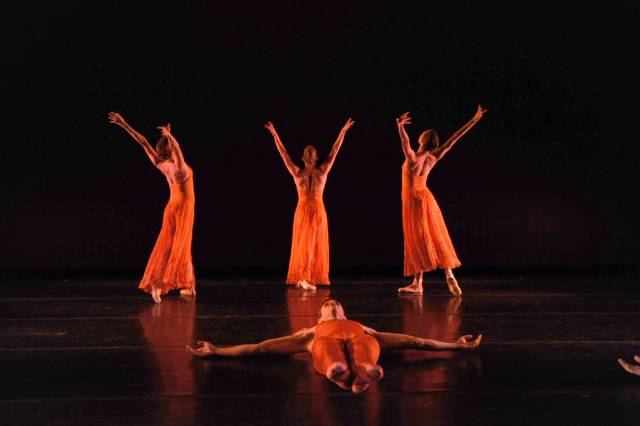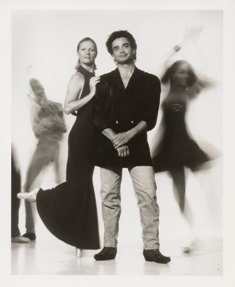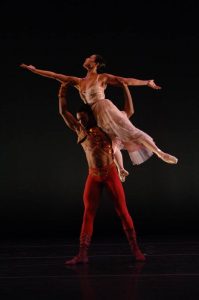

Co-artistic directors of Ballet NY (and married couple) Judith Fugate (Répétiteur) and Medhi Bahiri (Choreographer) have created a small, yet substantial company of accomplished dancers who take on works by renowned choreographers and emerging artists alike. It's pretty amazing what this company has been able to accomplish given their size: Since it was founded in 1997, Ballet NY has had twelve critically acclaimed seasons in a variety of NYC theaters, and from July 9-11at the Ailey Citigroup Theater, they will present a world premiere ballet by Bahiri as well as works by John Butler, William Forsythe and Stanton Welch.
I sat down with Fugate and Bahiri to discuss their 2015 season, the newest additions to their repertory, and just how this company works.
What about your company that distinguishes itself from other ballet companies in the city?
Fugate: Certainly the size. This year there are seven dancers, although usually we have around eight to ten. So, we are a small company. In many ways we felt that one of the more important things was to keep the company compact, especially for touring purposes. By doing so, we are keeping it affordable not only for venues but for ourselves, for our budget. We are more adaptable to smaller stages, something the larger companies can’t do. Or if they do, they can only use a portion of their company, which would limit them in terms of what types of ballets to present. As a contemporary ballet company doing the kind of rep that we do, this is the type of thing that makes us stand out from other companies.
You will be premiering your newest work, What Ever, on July 9th. Can you tell us a bit about the piece?
Medhi Bahiri: What Ever is a creation of mine. There’s not really much to say except that I love the music. It’s Samuel Barber's Concerto for Violin and Orchestra and it’s what inspired me. At the end of the day, I call it What Ever because I hadn’t decided on the title yet, so in the meantime it was “whatever for now.” And then it stuck. So it could have been “who cares.” It’s basically a very contemporary ballet; it's a duet based on classical technique but very contemporary and about nine minutes long.
Judith Fugate: It’s a long duet. To uphold the stage for that long for only two dancers is challenging.
 Who are the dancers for this piece?
Who are the dancers for this piece?
Fugate: Jesse Campbell and Xiaoxiao Cao. They work beautifully together. They’ve actually danced together previously elsewhere, so they work very beautifully together.
From what I’ve read, they are both quite accomplished as well, correct?
Fugate: That’s one of the most important things that we look for: accomplished, mature, professional dancers that are in the prime of their careers and wanting to search out more styles and different types of work. So, that’s what we are looking for when choosing new dancers.
Bahiri: If we had six months of rehearsals, we could probably take a few younger dancers and groom them, but we don’t have that luxury.
Did you create the dance for these dancers or did you work it out first?
Bahiri: I work it out first. Then, when we get into the studio and see the dancers, we decide who is going to do what. After that, I adapt to the dancers’ bodies according to what they can and cannot do.
Fugate: It’s interesting how sometimes they’ll just do something that happens naturally, and we like it! So it stays in.
Bahiri: It’s good to do that because it gets the dancers involved…you have to let the dancers give you feedback and feel it.
Tell us about what else we can expect to see in the upcoming program.
Bahiri: We have a Stanton Welch piece called Orange. He created that piece for us in…
Fugate: It premiered at the Joyce in 2001.
Bahiri: It’s a lovely piece, Vivaldi music.
Fugate: Various oboe concertos—extremely musical. The dancers always love performing it because it’s really comfortable and musical. Also, the audience loves it. That’s why we keep bringing it back.
Bahiri: Well, I wouldn’t say it’s comfortable. It’s enjoyable to perform, but the dance is not that comfortable, period. (laughs) Let’s not fool anyone here.
Fugate: (Laughs) Well, that's true.
So, spiritually comfortable more so than physically comfortable?
Fugate: Yes. It’s rewarding… unlike pieces that perhaps never feel enjoyable to dance.
Bahiri: Another piece is [William] Forsythe’s Slingerland. It’s hard to get comfortable in that kind of work. But, it’s a lot of fun to do. In this case, it’s new for us and for the dancers. So, it’s challenging.
Fugate: And it’s very opposite of Orange—a totally different concept.
Bahiri: All four pieces are very different.
Fugate: The opening ballet in the program is John Butler’s Othello, which we performed back in 2006 for the first time. It’s a dramatic (obviously) ballet with the three main characters set to Antonin Dvořák's Othello overture. It’s one of very few acting ballets that, to me, can still be very contemporary--contemporary and powerful. Donald Williams, who is a former principal dancer with Dance Theatre of Harlem, danced it in his career and staged it for us. What’s interesting is that Butler was very specific about the movement and the acting -- that the movement should create the acting instead of the acting making it happen. So it is very specific to his style of creating. It is, in another way, challenging for the dancers who have not performed his work before. So, it’s a very mixed up program with something for everyone.

Bahiri: That’s the way we like it. Otherwise we would do full-length ballets. But that’s not that interesting to us or for the dancers. That’s one of the reasons these dancers like to work with us, because we like to do so many different things in one program. So, they get to be challenged. And sometimes they have fun and sometimes they don’t (laughs). Overall, it’s enjoyable for the dancers as well as for the audience who we are also trying to cater to. They can go anywhere else and see a full-length, which is great, but...
Fugate: But, we try to have something on the program for everyone. Those who are William Forsythe followers will enjoy what we do even if they might not like Othello that much. Or, maybe someone will see something new on the program that they will like. I think it makes for developing new audiences so that they will return or tell their friends.
Bahiri: Hopefully we will attract some younger audiences. To get a young audience interested in ballet is so tough, especially with today’s technology. Giving them a program like this is good because maybe they don’t like three pieces, but they do like one.
I'd like to hear more about your working relationship.
Bahiri: First of all, we're directors. We make sure the dancers are guided. We're both there so if either of us has corrections, we give them. She's better at taking notes. I don't do that. (laughs)
FugatE: We're very "hands on." We're there at every rehearsal.
Bahiri: Right. Even if someone comes in to stage a ballet, we're there. We don't say "Okay, you've got the dancers for two hours. See ya!" We're there.
Fugate: We know all of the ballets, whether it's Medhi's piece or Othello, which someone came in to stage.
Bahiri: We learn them all because at some point we re-stage them ourselves.
Fugate: And we're responsible for the continuation of the work leading up to the performance. People rely on us to make sure things stay as they should be.
Where do you find balance within your respective roles?
Bahiri: We're like yin and yang.
Fugate: We share responsibilities outside of the studio, because it's all us. Administration, negotiating contracts, whatever comes up we share those responsibilities the best we can. Also, we each know who is better at what. I leave him to one thing and he leaves me to another. It balances out.
What do you see down the road for the company?
Fugate: So much is dependent on outside issues. First of all, support and funding for the arts is huge in a circumstance like ours, and in everyone's circumstance really. We are finding more and more difficulty finding studios to rehearse in because there seems to be less and less. For instance, here at the Ailey Center, they are starting their summer intensive so squeezing in the time for us to rent the space is a factor, since we don't have our own home. And year to year is different. Someone last year could have given us one thousand dollars and this year two hundred. You have to go with the flow and make the best of it. Certainly we would like to increase the size of the company, increase the amount of performances in New York, tour more, and so on. We have plans, but it's not totally dependent on what we want to do.
Ballet NY performs at the Ailey Citigroup Theater July 9-11.